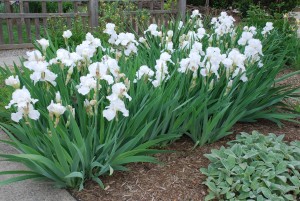Irises (Iris spp.) are beloved spring flowering perennials. Perhaps some fans and clumps flowered poorly this spring. There are several reasons for this, including: old clumps in need of dividing, weather issues, poorly drained soil, inadequate nutrition, too much nitrogen fertilizer, heavy shade, and pest and disease problems.
Irises do not compete well for space with other plants, including weeds. Heavy amounts of grassy weeds, including nutsedge, can quickly overtake iris fans and clumps. Plants become starved of nutrients resulting in poor growth and flowering.
As a rule, irises are dug up and divided every 4-5 years. Rhizomatous type irises (bearded, median, and Japanese) and clumping (Japanese roof, Siberian, flag) irises should be divided starting in late summer (August 15 to October 1) in USDA hardiness zones 5 to 7. In northerly areas, do not transplant iris after mid-October as they may heave out of the soil during the winter.
Prepare a new planting area and mix lots of rotted compost into a well-drained soil. The site should receive three-quarter to full day direct sunlight. Cut all fan leaves back to 4-6 inches. Irises are spaced 18 to 24 inches apart.
Select fans with plenty of white roots. Discard all old woody and gnarly fans with insect and disease symptoms and withered or dead foliage. Dispose with the household trash and not add to garden compost pile.
Do not fertilize new or reworked beds in the fall. Wait until spring. Feed with a slow release fertilizer such as Osmocote 14-14-14, Nutricote 13-13-13, or equivalent product. Irrigate newly planted irises until fall showers are plentiful.


 Posted in
Posted in 
